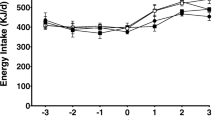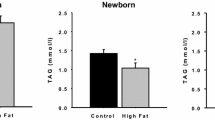Abstract
Docosahexaenoic acid (DHA) supply to the fetal brain depends upon the dam’s dietary intake of n-3 fats. In this study, we measured the incorporation of DHA into the fetal brain and liver in n-3 fatty acid deficient (0.1% alpha-linolenate) mice upon switching to an n-3 fatty acid adequate (2.1% alpha-linolenate) diet. Second generation mice raised and maintained on an n-3 deficient diet during mating were switched to an n-3 adequate diet on embryonic day 1 (ED 1) or ED 13. Fatty acid analysis was performed on fetal brains and livers and on maternal serum on ED 13, 15, 17, and 19. Although fetal brain and liver DHA began at a very low level (both exhibited an 85% decline), recovery was nearly complete by ED 15 in the group switched near conception but thereafter diverged. The maternal serum and fetal liver were very similar in their DHA and docosapentaenoic acid time courses. However, when repletion began on ED 13, brain DHA recovery was only about 44%. These results suggest that a nutritional intervention with alpha-linolenic acid can nearly but incompletely rescue the mouse fetal DHA deficiency if began at the time of conception but that the third trimester is too late, thus leaving a large DHA gap.




Similar content being viewed by others
Abbreviations
- DHA:
-
Docosahexaenoic acid, 22:6n-3
- DPAn-6:
-
Docosapentaenoic acid, 22:5n-6
- DTA:
-
Docosatetraenoic acid, 22:4n-6
- ALA:
-
Alpha-linolenic acid, 18:3n-3
- ARA:
-
Arachidonic acid, 20:4n-6
References
Kuhn DC, Crawford MA (1986) Placental essential fatty acid transport and prostaglandin synthesis. Prog Lipid Res 25:345–353
Ruyla M, Connor WE, Anderson GJ, Lowensohn RI (1990) Placental transfer of essential fatty acids in humans: venous-arterial difference for docosahexaenoic acid in fetal umbilical erythrocytes. Proc Natl Acad Sci USA 87:7902–7906
Haggarty P, Page K, Abramovich DR, Ashton J, Brown D (1997) Long-chain polyunsaturated fatty acid transport across the perfused human placenta. Placenta 18:635–642
Jensen CL (2006) Effects of n-3 fatty acids during pregnancy and lactation. Am J Clin Nutr 83:1452S–1457S
Hibbeln JR, Nieminen LRG, Blasbalg TL, Riggs JA, Lands WEM (2006) Healthy intakes of n-3 and n-6 fatty acids: estimations considering worldwide diversity. Am J Clin Nutr 83:1483S–1493S
Cunnane SC, Chen Z-Y (1992) Quantitative changes in long-chain fatty acids during fetal and early postnatal development in rats. Am J Physiol 262:R14–R19
Green P, Glozman S, Kamensky B, Yavin E (1999) Developmental changes in rat brain membrane lipids and fatty acids: the preferential prenatal accumulation of docosahexaenoic acid. J Lipid Res 40:960–966
Tam O, Innis SM (2006) Dietary polyunsaturated fatty acids in gestation alter fetal cortical phospholipids, fatty acids and phosphatidylserine synthesis. Dev Neurosci 28:222–229
Yonekubo A, Honda S, Okano M, Takahashi K, Yamamoto Y (1993) Dietary fish oil alters rat milk composition and liver and brain fatty acid composition of fetal and neonatal rats. J Nutr B123:1703–1708
Schiefermeier M, Yavin E (2002) n-3 Deficient and docosahexaenoic acid-enriched diets during critical periods of the developing prenatal rat brain. J Lipid Res 43:124–131
Bertrand PC, O’Kusky JR, Innis M (2006) Maternal dietary (n-3) fatty acid deficiency alters neurogenesis in the embryonic rat brain. J Nutr 136:1570–1575
Kunieda T, Xian M, Kobayashi E, Imamichi T, Moriwaki K, Toyoda Y (1992) Sexing of mouse preimplantation embryos by detection of Y chromosome-specific sequences using polymerase chain reaction. Biol Reprod 46:692–697
Reeves PG, Nielsen FH, Fahey GC (1993) Committee report on the AIN-93 purified rodent diet. J Nutr 123:1939–1951
Lepage G, Roy CC (1986) Direct transesterification of all classes of lipids in a one-step reaction. J Lipid Res 27:114–120
Masood A, Stark KD, Salem N Jr (2005) A simplified and efficient method for the analysis of fatty acid methyl esters suitable for large clinical studies. J Lipid Res 46:2299–2305
O’Brien JS, Sampson EL (1965) Fatty acid and aldehyde composition of the major brain lipids in normal gray matter, white matter and myelin. J Lipid Res 6:545–551
Salem N Jr (1989) Omega-3 fatty acids: molecular and biochemical aspects. In: Spiller G, Scala J (eds) New protective roles of selected nutrients in human nutrition. Alan R. Liss, New York, pp 109–228
Hamilton L, Greiner R, Salem N Jr, Kim HY (2000) n-3 Fatty acid deficiency decreases phosphatidylserine accumulation selectively in neonatal tissue. Lipids 35:863–869
Green P, Yavin E (1995) Modulation of fetal rat brain and liver phospholipids content by intraamniotic ethyl-docosahexaenoate administration. J Neurochem 65:2555–2560
Acknowledgment
We would like to thank Ms. Yasuda of Wakunaga Pharmaceutical Co., for identification of fetus sex by PCR.
Author information
Authors and Affiliations
Corresponding author
About this article
Cite this article
Harauma, A., Salem, N. & Moriguchi, T. Repletion of n-3 Fatty Acid Deficient Dams with α-Linolenic Acid: Effects on Fetal Brain and Liver Fatty Acid Composition. Lipids 45, 659–668 (2010). https://doi.org/10.1007/s11745-010-3443-y
Received:
Accepted:
Published:
Issue Date:
DOI: https://doi.org/10.1007/s11745-010-3443-y




